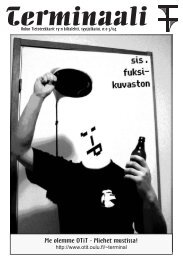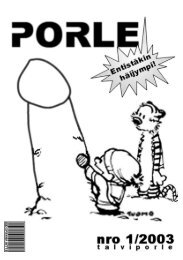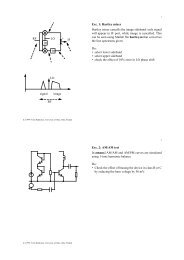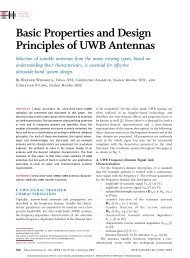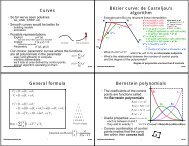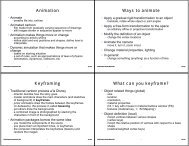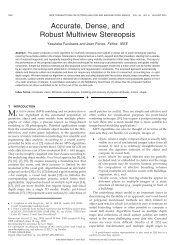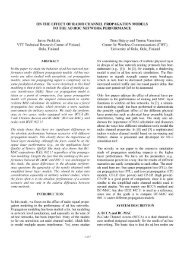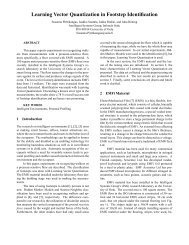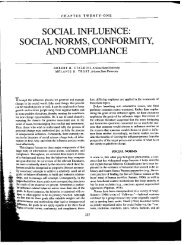Accurate and Practical Calibration of a Depth and Color ... - Oulu
Accurate and Practical Calibration of a Depth and Color ... - Oulu
Accurate and Practical Calibration of a Depth and Color ... - Oulu
Create successful ePaper yourself
Turn your PDF publications into a flip-book with our unique Google optimized e-Paper software.
know the exact pose <strong>of</strong> the camera. Lichti [7] proposes a calibration method<br />
for an individual laser range scanner using only a planar calibration object. It<br />
performs a comprehensive calibration <strong>of</strong> all parameters. However, it relies on<br />
the varying response <strong>of</strong> the scanner to different surface colors to locate corner<br />
features on the image.<br />
Zhu et al. [8] describe a method for fusing depth from stereo cameras <strong>and</strong><br />
ToF cameras. Their calibration uses the triangulation from the stereo cameras as<br />
ground truth. This ignores the possible errors in stereo triangulation <strong>and</strong> measurement<br />
uncertainties. The different cameras are thus calibrated independently<br />
<strong>and</strong> the parameters obtained may not be optimal.<br />
Motivation. As a motivation for our work, we propose three requirements<br />
that an optimal calibration algorithm must have. To the best <strong>of</strong> our knowledge,<br />
no available calibration algorithm for a depth <strong>and</strong> color camera pair fulfills all<br />
three criteria.<br />
<strong>Accurate</strong>: The method should provide the best combination <strong>of</strong> intrinsic <strong>and</strong><br />
extrinsic parameters that minimizes the reprojection error for both cameras over<br />
all calibration images. This may seem like an obvious principle but we stress it<br />
because partial calibrations, where each camera is calibrated independently <strong>and</strong><br />
the relative pose is estimated separately, may not achieve the best reprojection<br />
error.<br />
<strong>Practical</strong>: The method should be practical to use with readily available materials.<br />
A high precision 3D calibration object is not easy/cheap to obtain <strong>and</strong> a<br />
robotic arm or a high precision mechanical setup to record the exact pose <strong>of</strong> the<br />
camera pair is usually not practical, whereas a planar surface is usually readily<br />
available.<br />
Widely applicable: To be applicable to a wide range <strong>of</strong> depth sensors, one cannot<br />
assume that color discontinuities are visible on the depth image. Moreover,<br />
some depth sensors, like the one used for our experiments, may not provide accurate<br />
measurements at sharp depth discontinuities. Thus, neither color nor depth<br />
discontinuities are suitable features for depth camera calibration. The method<br />
should use features based on depth measurements that are most reliable for a<br />
wide range <strong>of</strong> cameras.<br />
2 The depth <strong>and</strong> color camera pair<br />
Our setup consists <strong>of</strong> one color camera <strong>and</strong> one depth sensor rigidly attached<br />
to each other. Our implementation <strong>and</strong> experiments use the Kinect sensor from<br />
Micros<strong>of</strong>t, which consists <strong>of</strong> a projector-camera pair as the depth sensor that<br />
measures per pixel disparity. The Kinect sensor has gained much popularity<br />
in the scientific <strong>and</strong> the entertainment community lately. The complete model<br />
includes 20 + 6N parameters where N is the number <strong>of</strong> calibration images. The<br />
details <strong>of</strong> the model are described below.<br />
<strong>Color</strong> camera intrinsics. We use a similar intrinsic model as Heikkilä <strong>and</strong><br />
Silven [1] which consists <strong>of</strong> a pinhole model with radial <strong>and</strong> tangential distortion<br />
correction. The projection <strong>of</strong> a point from color camera coordinates<br />
xc = [xc, yc, zc] ⊤ to color image coordinates p c = [uc, vc] ⊤ is obtained through




